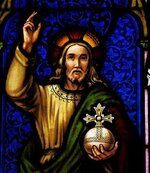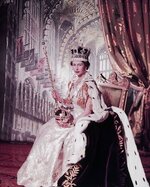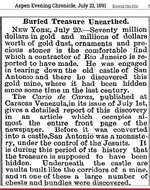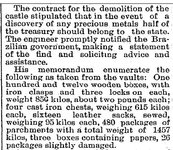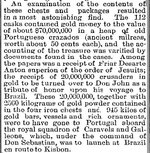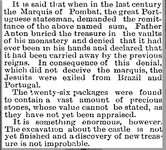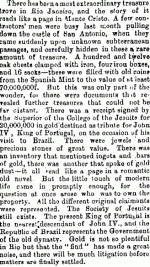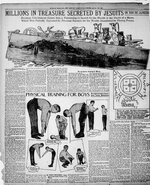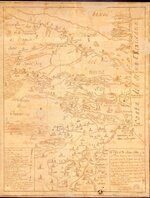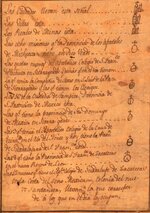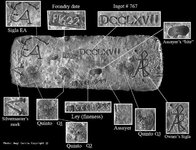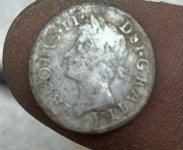gollum
Gold Member
- Jan 2, 2006
- 6,729
- 7,594
- Detector(s) used
- Minelab SD2200D (Modded)/ Whites GMT 24k / Fisher FX-3 / Fisher Gold Bug II / Fisher Gemini / Schiebel MIMID / Falcon MD-20
- Primary Interest:
- All Treasure Hunting
Hello All,
Since the greatest majority of my searching and researching pertains to Land Treasures (Lost Mines, Hidden Caches, etc), I don't venture too often into the Shipwreck Forums. Now our paths have crossed, and I need a little help if y'all don't mind.
Several years ago, I was researching one aspect of a Jesuit Treasure Legend. One symbol I have seen repeated MANY times on Jesuit Treasure Bars found on land is the "Cross & V". I have good (the best) sources for Jesuit Historical Stuff; Father John O'Malley SJ, who is probably the most renowned (living) scholar of early Jesuit History at Georgetown University. Even he had no idea what the symbol meant (at least that is what he said). The best he could offer was that possibly the "V" stood for The Virgin Mary. Here are a few examples:
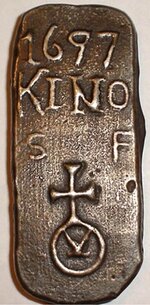
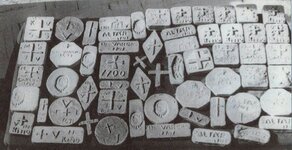
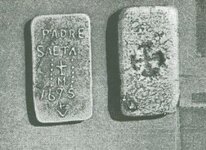
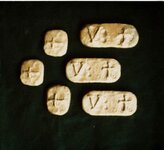
That symbol has haunted me for many years. I HATE not being able to figure things out! HAHAHA I actually do have a few ideas on it, but there has never been anything found in writing that describes it. The main reason I believe it has haunted me, is because another famous Jesuit Historian (the late Father Charles Polzer SJ) used to poopoo any bars that were supposed to have been Jesuit in origin. He said that since the Jesuit Order had no wealth or treasure, the bars MUST be fake! So, not only am I not able to figure the meaning of the symbol, there was the guy that was in a position to know about this, saying they were all fakes. Were they REALLY all fakes?
NO! They are not all fakes. I personally know the provenance for the bars in the last two pictures:
1. Attributed directly to Padre Kino, and belongs to a gentleman in Tucson, Az. Don't personally know him, and can't attest (personally) to its authenticity.
2. A 1961 picture of a table full of silver bars that were being sold by a Yaqui Indian, who said they were recovered from a mule train massacre site in Mexico. Don't have any personal involvement, and don't know any of the people involved. I can't attest to the authenticity of these bars either.
3. This is one of 1028 (yes, one thousand and twenty-eight) silver bars that were found West of Highway 19 between Tucson and Nogales, Az. These bars were found by Chuck Kenworthy (and The Quest). These bars, I will vouch for as authentic.
4. These bars were found by Ron Quinn (of Tucson, Az), his brother, their treasure hunting expert friend, and their engineer friend in 1983 (they were written about in TREASURE! Magazine in August 1986:
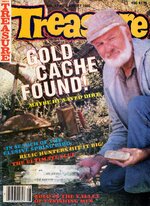
I know Ron Quinn, and I will personally vouch for the authenticity of these bars. Funny thing is....these bars were found in fairly close proximity to the silver bars in #3. I believe they are related (but that is another story).
Cut to about a year ago. I was looking through my copy of "Spanish Treasure Bars From New World Shipwrecks". I was looking in the section about the Atocha, and was floored when I took a close look at the pic at the top of page 59:
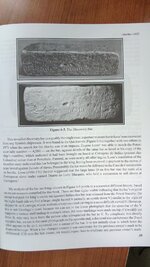
It describes this as one of the most important finds of the entire Atocha Story. It was not taken aboard in Panama (as most bars were). It was on the manifest as tally# 4984 from the Potosi Mint, but it was loaded in Cartagena (Columbia). It is described as being the King's Quinto, that belonged to a Slave Trader named Duarte de Leon Marquez. The symbol on the opposite end of the bar is described as an "A" over an inverted Cross. ANYBODY that knows anything about JUST HOW Religious the Spaniards were/are, would know they would NEVER either invert a Cross or subjugate it under something else. Also, if you look closely at the bar, if you have it where the "D" is oriented correctly, the rest of the bar is upside down. If you orient the bar where you can read everything else, something amazing happens; what is described as an "A over a Cross" is our famous "Cross & V" of the Jesuit Order:
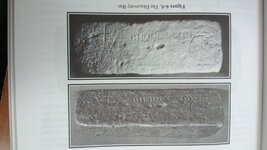
Now, is that just a coincidence? There are a few things that tell me NO! It is most definitely NOT a coinkydink!
1. The bar was cast at the Potosi Mint in Bolivia. Bolivia was a MAJOR Jesuit area of operation. The Jesuits actually had a plan set up to buy Bolivia from Spain, and make it a Jesuit Colony. The Order had a ton of silver and gold mines in Bolivia (I think about two dozen rich mines along The Sacambaya River alone).
2. The bar was brought aboard at Cartagena, Columbia, and not Portobelo, Panama. A typical silver bar from the Potosi Mint, would have typically been taken to Panama for shipment to Cuba, and on to Spain. The closest large port to the Jesuits in Bolivia would have been Cartagena.
3. It also makes sense that the bar was being shipped by Duarte de Leon Marquez. Most people do not know that The Jesuit Order was one of the largest slaveholders in the New World. They would have been dealing with slave traders on a regular basis.
In short.... a bunch of circumstantial evidence leading back to this bar (at one time) belonging to The Jesuit Order.
So.........all that being said, why is it important that this bar belonged to the Jesuits? It doesn't matter that this bar indicates the Jesuits had wealth. We know they did/do. It doesn't matter that the Jesuits were slaveholders. That was just how people did things back then. It matters, because of that DAMN "Cross & V" Symbol! That bar came out of the water long before Father Polzer stated unequivocally that there were no (authentic) Jesuit Treasure Bars ANYWHERE! THAT "Cross & V" date back to 1622..............and they came from the bottom of the Caribbean. ZERO chance of it being a fraud.
So now that we've come the long way around the bush, here's my question:
Where is that bar today, and is there any way to get some good hi-res pics of it?
Any help is greatly appreciated.
Mike
PS
Also, does anybody know if ANY other bars with this symbol have been found?
Since the greatest majority of my searching and researching pertains to Land Treasures (Lost Mines, Hidden Caches, etc), I don't venture too often into the Shipwreck Forums. Now our paths have crossed, and I need a little help if y'all don't mind.
Several years ago, I was researching one aspect of a Jesuit Treasure Legend. One symbol I have seen repeated MANY times on Jesuit Treasure Bars found on land is the "Cross & V". I have good (the best) sources for Jesuit Historical Stuff; Father John O'Malley SJ, who is probably the most renowned (living) scholar of early Jesuit History at Georgetown University. Even he had no idea what the symbol meant (at least that is what he said). The best he could offer was that possibly the "V" stood for The Virgin Mary. Here are a few examples:




That symbol has haunted me for many years. I HATE not being able to figure things out! HAHAHA I actually do have a few ideas on it, but there has never been anything found in writing that describes it. The main reason I believe it has haunted me, is because another famous Jesuit Historian (the late Father Charles Polzer SJ) used to poopoo any bars that were supposed to have been Jesuit in origin. He said that since the Jesuit Order had no wealth or treasure, the bars MUST be fake! So, not only am I not able to figure the meaning of the symbol, there was the guy that was in a position to know about this, saying they were all fakes. Were they REALLY all fakes?
NO! They are not all fakes. I personally know the provenance for the bars in the last two pictures:
1. Attributed directly to Padre Kino, and belongs to a gentleman in Tucson, Az. Don't personally know him, and can't attest (personally) to its authenticity.
2. A 1961 picture of a table full of silver bars that were being sold by a Yaqui Indian, who said they were recovered from a mule train massacre site in Mexico. Don't have any personal involvement, and don't know any of the people involved. I can't attest to the authenticity of these bars either.
3. This is one of 1028 (yes, one thousand and twenty-eight) silver bars that were found West of Highway 19 between Tucson and Nogales, Az. These bars were found by Chuck Kenworthy (and The Quest). These bars, I will vouch for as authentic.
4. These bars were found by Ron Quinn (of Tucson, Az), his brother, their treasure hunting expert friend, and their engineer friend in 1983 (they were written about in TREASURE! Magazine in August 1986:

I know Ron Quinn, and I will personally vouch for the authenticity of these bars. Funny thing is....these bars were found in fairly close proximity to the silver bars in #3. I believe they are related (but that is another story).
Cut to about a year ago. I was looking through my copy of "Spanish Treasure Bars From New World Shipwrecks". I was looking in the section about the Atocha, and was floored when I took a close look at the pic at the top of page 59:

It describes this as one of the most important finds of the entire Atocha Story. It was not taken aboard in Panama (as most bars were). It was on the manifest as tally# 4984 from the Potosi Mint, but it was loaded in Cartagena (Columbia). It is described as being the King's Quinto, that belonged to a Slave Trader named Duarte de Leon Marquez. The symbol on the opposite end of the bar is described as an "A" over an inverted Cross. ANYBODY that knows anything about JUST HOW Religious the Spaniards were/are, would know they would NEVER either invert a Cross or subjugate it under something else. Also, if you look closely at the bar, if you have it where the "D" is oriented correctly, the rest of the bar is upside down. If you orient the bar where you can read everything else, something amazing happens; what is described as an "A over a Cross" is our famous "Cross & V" of the Jesuit Order:

Now, is that just a coincidence? There are a few things that tell me NO! It is most definitely NOT a coinkydink!
1. The bar was cast at the Potosi Mint in Bolivia. Bolivia was a MAJOR Jesuit area of operation. The Jesuits actually had a plan set up to buy Bolivia from Spain, and make it a Jesuit Colony. The Order had a ton of silver and gold mines in Bolivia (I think about two dozen rich mines along The Sacambaya River alone).
2. The bar was brought aboard at Cartagena, Columbia, and not Portobelo, Panama. A typical silver bar from the Potosi Mint, would have typically been taken to Panama for shipment to Cuba, and on to Spain. The closest large port to the Jesuits in Bolivia would have been Cartagena.
3. It also makes sense that the bar was being shipped by Duarte de Leon Marquez. Most people do not know that The Jesuit Order was one of the largest slaveholders in the New World. They would have been dealing with slave traders on a regular basis.
In short.... a bunch of circumstantial evidence leading back to this bar (at one time) belonging to The Jesuit Order.
So.........all that being said, why is it important that this bar belonged to the Jesuits? It doesn't matter that this bar indicates the Jesuits had wealth. We know they did/do. It doesn't matter that the Jesuits were slaveholders. That was just how people did things back then. It matters, because of that DAMN "Cross & V" Symbol! That bar came out of the water long before Father Polzer stated unequivocally that there were no (authentic) Jesuit Treasure Bars ANYWHERE! THAT "Cross & V" date back to 1622..............and they came from the bottom of the Caribbean. ZERO chance of it being a fraud.
So now that we've come the long way around the bush, here's my question:
Where is that bar today, and is there any way to get some good hi-res pics of it?
Any help is greatly appreciated.
Mike
PS
Also, does anybody know if ANY other bars with this symbol have been found?
Last edited:


